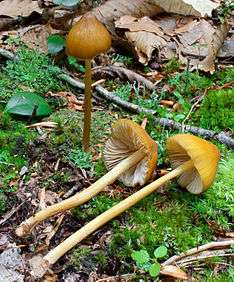Entoloma luteum
| Entoloma luteum | |
|---|---|
 | |
| Scientific classification | |
| Kingdom: | Fungi |
| Division: | Basidiomycota |
| Class: | Agaricomycetes |
| Order: | Agaricales |
| Family: | Entolomataceae |
| Genus: | Entoloma |
| Species: | E. luteum |
| Binomial name | |
| Entoloma luteum Peck (1902) | |
| Synonyms[1] | |
Entoloma luteum is a mushroom in the family Entolomataceae. It was described in 1902 by mycologist Charles Horton Peck.[4] Found in North America, it fruits singly or in clusters on the ground in mixed forest. Its angular spores are non-amyloid, hyaline (translucent), and measure 9–13 by 8–12 µm. Entoloma murrayi is a lookalike species that has a more orange cap with a pointy umbo.[5]
See also
References
- ↑ "GSD Species Synonymy: Entoloma luteum Peck". Species Fungorum. CAB International. Retrieved 2014-08-08.
- ↑ Smith AH. (1953). "New and rare agarics from the Douglas Lake region and Tahquamenon Falls State Park, Michigan, and an account of the North American species of Xeromphalina". Papers of the Michigan Academy of Sciences. 38: 53–87.
- ↑ Baroni TJ, Halling RE. (2000). "Some Entolomataceae (Agaricales) from Costa Rica". Brittonia. 52: 121–35. doi:10.2307/2666502.
- ↑ Peck CH. (1902). "Report of the State Botanist (1900)". Annual Report on the New York State Museum of Natural History. 54: 131–99.
- ↑ Roody WC. (2003). Mushrooms of West Virginia and the Central Appalachians. Lexington, Kentucky: University Press of Kentucky. p. 195. ISBN 978-0-8131-9039-6.
External links
This article is issued from Wikipedia - version of the 10/11/2016. The text is available under the Creative Commons Attribution/Share Alike but additional terms may apply for the media files.